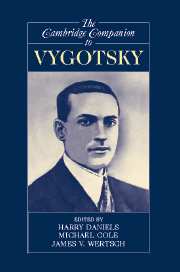Book contents
- Frontmatter
- Editors’ Introduction
- Part I: Vygotsky in Context
- Part II: Readings of Vygotsky
- 6 Terminology in L. S. Vygotsky’s Writings
- 7 Mediation
- 8 Vygotsky and Culture
- 9 Thought and Word: The Approaches of L. S. Vygotsky and G. G. Shpet
- 10 The Development of Children’s Conceptual Relation to the World, with Focus on Concept Formation in Preschool Children's Activity
- 11 Inside and Outside the Zone of Proximal Development: An Ecofunctional Reading of Vygotsky
- Part III: Applications of Vygotsky’s Work
- References
- Index
7 - Mediation
from Part II: - Readings of Vygotsky
Published online by Cambridge University Press: 28 November 2007
- Frontmatter
- Editors’ Introduction
- Part I: Vygotsky in Context
- Part II: Readings of Vygotsky
- 6 Terminology in L. S. Vygotsky’s Writings
- 7 Mediation
- 8 Vygotsky and Culture
- 9 Thought and Word: The Approaches of L. S. Vygotsky and G. G. Shpet
- 10 The Development of Children’s Conceptual Relation to the World, with Focus on Concept Formation in Preschool Children's Activity
- 11 Inside and Outside the Zone of Proximal Development: An Ecofunctional Reading of Vygotsky
- Part III: Applications of Vygotsky’s Work
- References
- Index
Summary
Mediation is a theme that runs throughout the writings of Lev Semënovich Vygotsky. In his view, a hallmark of human consciousness is that it is associated with the use of tools, especially “psychological tools” or “signs.” Instead of acting in a direct, unmediated way in the social and physical world, our contact with the world is indirect or mediated by signs. This means that understanding the emergence and the definition of higher mental processes must be grounded in the notion of mediation.
Mediation also provides the foundation for another of Vygotsky's theoretical goals, namely, building a link between social and historical processes, on the one hand, and individuals' mental processes, on the other. It is because humans internalize forms of mediation provided by particular cultural, historical, and institutional forces that their mental functioning sociohistorically situated.
The importance that Vygotsky attached to mediation is reflected in a lecture he delivered near the end of his life, where he asserted, “A central fact of our psychology is the fact of mediation [oposredovanie]” (Vygotsky, 1982, p. 166). But this is an issue that concerned him from the beginning of his career onward. In a 1930 report on “The Instrumental Method in Psychology,” for example, he focused on the importance of signs as “artificial formations . . . [that] are social, not organic or individual” (Vygotsky, 1981, p. 137) and he included under this heading: “language; various systems for counting; mnemonic techniques; algebraic symbol systems; works of art; writing; schemes, diagrams, maps, and mechanical drawings; all sorts of conventional signs” (Vygotsky, 1981, p. 137).
- Type
- Chapter
- Information
- The Cambridge Companion to Vygotsky , pp. 178 - 192Publisher: Cambridge University PressPrint publication year: 2007
- 243
- Cited by



